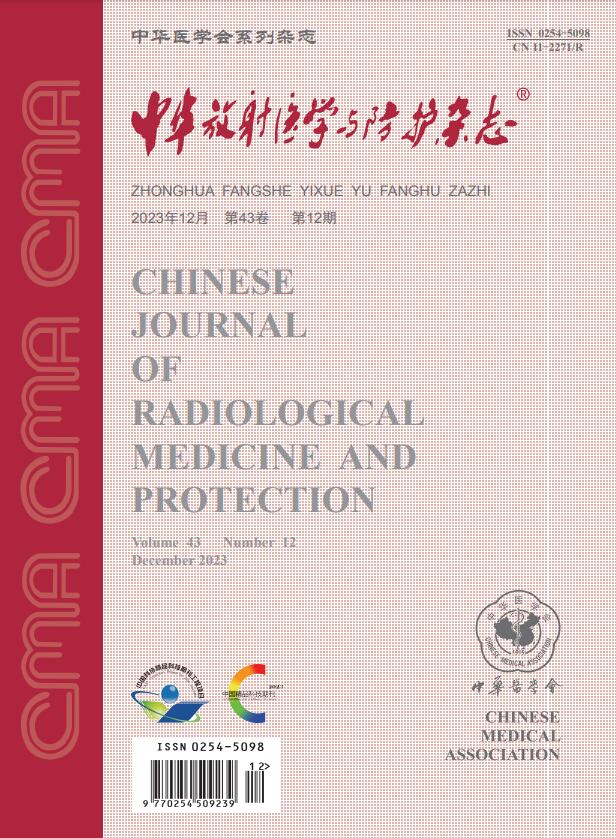Current status of the application of radiodiagnosis and radiotherapy resources in Huai'an City in 2020
B. Huo, Z. Xu, X. Chen
{"title":"Current status of the application of radiodiagnosis and radiotherapy resources in Huai'an City in 2020","authors":"B. Huo, Z. Xu, X. Chen","doi":"10.3760/cma.j.issn.0254-5098.2021.07.006","DOIUrl":null,"url":null,"abstract":"Objective: To investigate the current status of the radiodiagnosis and radiotherapy resources and medical exposure frequencies in Huai'an City. Methods: According to the monitoring data in the \" Radiological Health Information Management Platform of Jiangsu Province\" in 2020, a descriptive analysis was conducted on the personnel, equipment, and exposure frequencies in the institutes engaged in radiation-based diagnosis and treatment in Huai'an. Results: A total of 181 hospitals were investigated in 2020, including 7 tertiary hospitals(3.9%), 24 secondary hospitals(13.3%), 126 primary hospitals(69.6%), and 24 ungraded hospitals(13.3%). There were 1 397 radiation workers, including 948 males and 449 females, and 459 pieces of radiation equipment, including 420 for radio diagnosis, 13 for radiotherapy, 4 for nuclear medicine, and 22 for interventional radiology. The hospitals of different grades greatly differed in the number of radiation workers and equipment. There were 80.1, 20.9, 2.2, and 2.0 radiation workers and 15.7, 5.5, 1.4, and 1.6 pieces of radiation equipment in the tertiary hospitals, secondary hospitals, primary hospitals, and ungraded hospitals, respectively on average. There were 2 903 246, 27 648, 8 087, and 17 874 receiving radiodiagnosis, radiotherapy, nuclear medicine, and interventional radiology, respectively in 2020. The medical exposure frequencies in the whole city were calculated to be 599.50 per 1 000 population, including 334.59 treated with conventional X-rays, 239.82 receiving CT scan, 14.18 for breast and dentistry, 3.62 receiving interventional radiology, 5.61 treated with radiotherapy, and 1.69 receiving nuclear medicine. Conclusions: The radiodiagnosis and radiotherapy resources are unbalanced in the hospitals of different grades in Huai'an City. Therefore, it is necessary to pay more attention to the reasonable allocation of medical resources. Meanwhile, radiation workers in secondary hospitals may be more prone to job burnout. Facing the normalization of the prevention and control of COVID-19 epidemic, the supervision and management of radiological health should be strengthened to ensure the legitimacy of radiological diagnosis and radiotherapy and theoptimization of protection. The frequencies of medical exposure are consistent with the local economic level. To analyze the differences in medical exposure frequencies and predict the developmental trends in different regions, it is necessary to establish a more accurate prediction model. Copyright © 2021 by the Chinese Medical Association.","PeriodicalId":36403,"journal":{"name":"中华放射医学与防护杂志","volume":"6 1","pages":"509-513"},"PeriodicalIF":0.0000,"publicationDate":"2021-01-01","publicationTypes":"Journal Article","fieldsOfStudy":null,"isOpenAccess":false,"openAccessPdf":"","citationCount":"0","resultStr":null,"platform":"Semanticscholar","paperid":null,"PeriodicalName":"中华放射医学与防护杂志","FirstCategoryId":"3","ListUrlMain":"https://doi.org/10.3760/cma.j.issn.0254-5098.2021.07.006","RegionNum":0,"RegionCategory":null,"ArticlePicture":[],"TitleCN":null,"AbstractTextCN":null,"PMCID":null,"EPubDate":"","PubModel":"","JCR":"Q4","JCRName":"Medicine","Score":null,"Total":0}
引用次数: 0
Abstract
Objective: To investigate the current status of the radiodiagnosis and radiotherapy resources and medical exposure frequencies in Huai'an City. Methods: According to the monitoring data in the " Radiological Health Information Management Platform of Jiangsu Province" in 2020, a descriptive analysis was conducted on the personnel, equipment, and exposure frequencies in the institutes engaged in radiation-based diagnosis and treatment in Huai'an. Results: A total of 181 hospitals were investigated in 2020, including 7 tertiary hospitals(3.9%), 24 secondary hospitals(13.3%), 126 primary hospitals(69.6%), and 24 ungraded hospitals(13.3%). There were 1 397 radiation workers, including 948 males and 449 females, and 459 pieces of radiation equipment, including 420 for radio diagnosis, 13 for radiotherapy, 4 for nuclear medicine, and 22 for interventional radiology. The hospitals of different grades greatly differed in the number of radiation workers and equipment. There were 80.1, 20.9, 2.2, and 2.0 radiation workers and 15.7, 5.5, 1.4, and 1.6 pieces of radiation equipment in the tertiary hospitals, secondary hospitals, primary hospitals, and ungraded hospitals, respectively on average. There were 2 903 246, 27 648, 8 087, and 17 874 receiving radiodiagnosis, radiotherapy, nuclear medicine, and interventional radiology, respectively in 2020. The medical exposure frequencies in the whole city were calculated to be 599.50 per 1 000 population, including 334.59 treated with conventional X-rays, 239.82 receiving CT scan, 14.18 for breast and dentistry, 3.62 receiving interventional radiology, 5.61 treated with radiotherapy, and 1.69 receiving nuclear medicine. Conclusions: The radiodiagnosis and radiotherapy resources are unbalanced in the hospitals of different grades in Huai'an City. Therefore, it is necessary to pay more attention to the reasonable allocation of medical resources. Meanwhile, radiation workers in secondary hospitals may be more prone to job burnout. Facing the normalization of the prevention and control of COVID-19 epidemic, the supervision and management of radiological health should be strengthened to ensure the legitimacy of radiological diagnosis and radiotherapy and theoptimization of protection. The frequencies of medical exposure are consistent with the local economic level. To analyze the differences in medical exposure frequencies and predict the developmental trends in different regions, it is necessary to establish a more accurate prediction model. Copyright © 2021 by the Chinese Medical Association.
2020年淮安市放射诊断与放疗资源应用现状
目的:了解淮安市放射诊断和放疗资源现状及医疗照射频率。方法:根据“江苏省放射卫生信息管理平台”2020年监测数据,对淮安市从事放射诊疗的机构人员、设备、暴露频次进行描述性分析。结果:2020年共调查医院181家,其中三级医院7家(3.9%),二级医院24家(13.3%),一级医院126家(69.6%),未分级医院24家(13.3%)。放射工作人员1397人,其中男948人,女449人;放射设备459台,其中放射诊断设备420台,放射治疗设备13台,核医学设备4台,介入放射设备22台。不同等级的医院在辐射工作人员数量和设备数量上存在较大差异。三级医院、二级医院、基层医院、基层医院辐射工作人员平均人数分别为80.1人、20.9人、2.2人、2.0人,辐射设备平均配备15.7人、5.5人、1.4人、1.6人。2020年接受放射诊断、放射治疗、核医学和介入放射治疗的人数分别为2 903 246人、27 648人、8 087人、17 874人。计算出全市医疗暴露频率为599.50 / 1000人,其中常规x线照射334.59人,CT扫描239.82人,乳腺和牙科14.18人,介入放射3.62人,放疗5.61人,核医学1.69人。结论:淮安市不同级别医院放射诊断和放疗资源不均衡。因此,必须更加重视医疗资源的合理配置。与此同时,二级医院的辐射工作人员可能更容易出现职业倦怠。面对新冠肺炎疫情防控常态化,应加强放射卫生监督管理,确保放射诊断、放疗的合法性和防护的优化。医疗暴露频率与当地经济水平一致。为了分析不同地区医疗暴露频率的差异,预测不同地区医疗暴露频率的发展趋势,有必要建立更准确的预测模型。中华医学会版权所有©2021。
本文章由计算机程序翻译,如有差异,请以英文原文为准。


